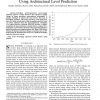Free Online Productivity Tools
i2Speak
i2Symbol
i2OCR
iTex2Img
iWeb2Print
iWeb2Shot
i2Type
iPdf2Split
iPdf2Merge
i2Bopomofo
i2Arabic
i2Style
i2Image
i2PDF
iLatex2Rtf
Sci2ools
TVLSI
2002
2002
On-chip decoupling capacitor optimization using architectural level prediction
Switching activity-generated power-supply grid-noise presents a major obstacle to the reduction of supply voltage in future generation semiconductor technologies. A popular technique to counter this issue involves the usage of decoupling capacitors. This paper presents a novel design technique for sizing and placing on-chip decoupling capacitors based on activity signatures from the microarchitecture. Simulation of a typical processor workload (SPEC95) provides a realistic stimulation of microarchitecture elements that is coupled with a spatial power grid model. Evaluation of the proposed technique on typical microprocessor implementations (the Alpha 21264 and the Pentium II) indicates that this technique can produce up to a 30% improvement in maximum noise levels over a uniform decoupling capacitor placement strategy.
Activity-generated Power-supply Grid-noise | Decoupling Capacitor | On-chip Decoupling Capacitors | TVLSI 2002 |
| Added | 23 Dec 2010 |
| Updated | 23 Dec 2010 |
| Type | Journal |
| Year | 2002 |
| Where | TVLSI |
| Authors | Mondira Deb Pant, Pankaj Pant, D. Scott Wills |
Comments (0)

